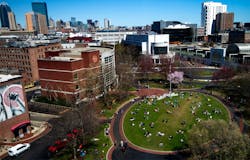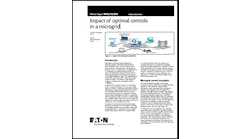Northeastern University Aims to Set New Standard for Higher Ed with Advanced Microgrid
Northeastern University says it is developing a microgrid that sets the bar for higher education, using a self-funded approach to harden its campus resiliency while achieving sustainability goals.
Now in planning, the integrated microgrid will serve the university’s 73-acre campus in Boston, a city that experiences urban power congestion and coastal challenges.
The university began exploring options to improve its electric reliability two years ago after a prolonged power outage that affected its students.
Courtesy of Northeastern University
“There was an event where the power supply, our electricity, went down for about a week. Our residence halls did lose power for a period of time,” said Maria Cimilluca, vice president for facilities, Northeastern University, a top 100 school in the US News & World Report rankings.
The university sees the microgrid as a means to not only ensure reliable power, but also to reduce its carbon dioxide emissions 80% by 2050 (and possibly reach complete carbon neutrality), a goal Northeastern set several years ago as a signatory to the American College and University Presidents Climate Commitment (ACUPCC).
More recently, the university has decided to move more aggressively and align itself with the City of Boston to become carbon neutral.
The microgrid is an economic play as well — the university wants to reduce operating costs and improve cash flow.
How the project pays for itself
Working with a strategic partner, Northeastern is designing a utility master plan that focuses on a range of campus energy improvements to save money as well as position itself to mitigate the volatility of the evolving energy markets. They include energy efficiency measures, new supply contracts, energy resilience savings, and strategies to reduce electric demand charges and better manage water use. The university also will leverage the microgrid for demand response, ancillary services and electricity market transactions.
Various state and federal incentives will help offset some of this investment, such as Massachusetts green community funding. The project also will tap into revenue potential from selling credits through the state’s alternative portfolio standard, set at a ceiling of $23.13/MWh for 2019.
Learn more about the Northeastern University microgrid at a special session during Microgrid 2019, “The Campus Microgrid,” on May 15 in San Diego.
The project is designed so that the energy savings can pay for all the capital improvements, not requiring an upfront capital investment by Northeastern,” Cimilluca said. “It is a unique way to fund what will be one of the most comprehensive integrated microgrids on a university campus that supports the university’s sustainability and educational goals.”
As envisioned, Northeastern’s microgrid project will encompass 36 energy conservation measures, a large combined heat and power plant, battery energy storage, additional peaking generation, thermal supply, and electrical system upgrades. The plan also contemplates on-site and off-site solar, possibly designed to share output with the surrounding community.
Northeastern now purchases all of its energy from outside sources, 90,000 MWh of electricity and 570,000 MMBtu of natural gas. It wants to size the microgrid with enough on-site power to serve the primary campus during an outage. The system will be designed for seamless islanding. If an outage occurs on the grid, the microgrid instantly kicks into action, so those on campus are unaware of any disturbance.
A city that supports microgrids
Cimilluca noted that the project has the good fortune of being housed in a city that supports microgrids, further codifying a long-term partnership between Northeastern and the city. Boston last year adopted a Smart Utilities Policy that requires projects over 1.5 million square feet to evaluate the feasibility of a district energy microgrid.
While the Northeastern project encompasses a host of technologies and strategies common to microgrids, it also tests out some more futuristic ideas. For example, the university plans to incorporate electric vehicle charging stations, but wants to be sure the power they consume does not come from high-carbon sources, like coal-fired plants. So the university is exploring the idea of sourcing renewable natural gas to fuel the CHP plant and the other fossil fuel consuming prime movers.
Northeastern’s leg up over rival engineering schools
In keeping with the university’s mission, the project is being constructed as a “living learning lab” where engineering students can get hands-on experience working on the microgrid and its connected advanced energy technologies. This feature is especially important to Northeastern since the school is known globally for its cooperative learning program, begun in 1909 with eight engineering students. Now, supported by $59 million in annual federal funding, Northeastern’s college of engineering encompasses 13 multi-institutional research centers and 170 tenured/tenure track faculty focused on experiential learning.
Given that the project will use some of the most advanced energy technology available, Northeastern will gain a leg up over rival engineering programs, Cimilluca said.
“Imagine you’re a student attending Northeastern to secure an engineering degree, and for many of those years you’re actually working on a live comprehensive microgrid that is serving this amazing campus as well as participating in the ISO market. That’s very powerful to have on your resume,” Cimilluca said.
Northeastern expects the energy project to take about three years to complete, more time than it would take if the site were unoccupied, since university operations must continue without disruption.
Read more about campus microgrids here on Microgrid Knowledge.







